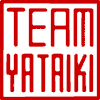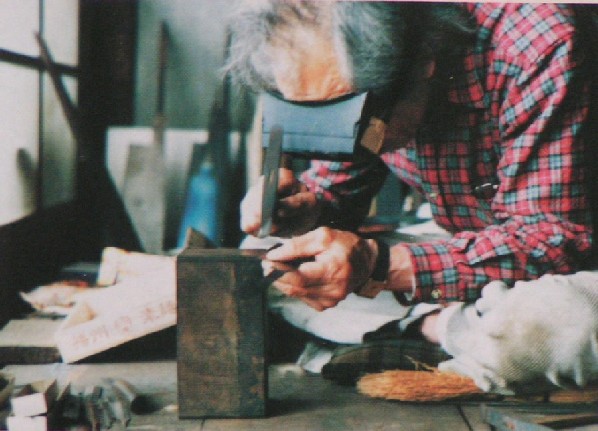


"Yataiki", by Mark Grable
Endo Tomoya goes by several names. Miyano Tetsu No Suke is a title given to his great-grandfather by the Emperor for making the best saws in Japan. His grandfather and father used the same title, but since Endo decided he could not improve their process, he used the name Miyano Dai Endo. When I met him he was going by a name he chose for himself, Yataiki. Blacksmithing and saw sharpening are only two of the arts he has mastered. As a young man he trained as a runner and studied Noh theater. Before making saws, the Endo family made swords, and since all the arts and technology in Japan went into and came out of swords (and Buddhism), Yataiki has also studied the arts of tea ceremony, bonzai, haiku, and calligraphy. The notebook he made while studying calligraphy contains many haiku and folk songs; he is part of a lineage that connects back to Basho, Kaikei, and other great artists of Japan’s past. Miyano Dai Endo first came to the United States back in 1984, as part of a series of seminars organized by Robert Majors, a tool-importing entrepeneur who had sought out Yataiki and other master craftsmen in their Miki City, Japan shops.

He returned to the U.S. in 1992, giving a four-week workshop in Iowa, which is where I met him. Yataiki came to
the Midwest to teach traditional tool making in 1993, and, over six weeks, he demonstrated his blacksmithing skills
for two dozen or more woodworkers and metal workers. Many of the friends he met in the United States have since
visited his home in Miki City, and I spent three months there learning saw sharpening. In the time I worked with
Yataiki, I began to learn the importance of rhythm, of making music while you work; of working with an open, attentive,
no-thought mind; of beginning work with recognition (satori); and the importance of working with the attitude of
shin ken (facing an opponent with sword); working with ki in your hands and working it into the saw; and simply
being friends with your tools. Rhythm and sound were very central. He didn't watch me; he listened. When I first
arrived, he had just started making 108 kiri presentation boxes for a Buddhist temple to give to graduating monks.
These were 2" x 4-1/2" x 10", and would hold two padouk clappers and two padouk rings for the priests’
aprons. This woodworking was the focus of his workday, and between stages, or when I made really wrong sounds,
he gave me demonstrations. He didn't have to watch me; he knew what I was doing by listening, and while generally
he was happy with the way things came out, the thing he really felt to be most important was rhythm: if the thing
had rhythm, it was bound to look good. No matter how good it looked, if it didn't have rhythm, he wasn't interested.
Mr.Matsumoto, a temple builder, said the same thing—he and Yataiki were discussing the difficulties I was having
with setting teeth, which is done with a small hammer on the edge of an anvil. Mr. Matsumoto went on to explain,
holding his hand over the area of the navel, that the rhythm comes from the belly. It takes Yataiki 4-6 hours to
finish hammer (after miyagi) one blade. I doubt he sits there thinking “Just two more hours of packing this steel,
and then time for okashi (tea and cookies).” He is sculpting a surface, using various rhythms, which are complex,
and remind me of Gamalong music, or Taiko drumming, or part of a folk song. He does it like mixed-up jazz, but
when he is done, his blades look like a calm ocean when viewed from far away. Sometimes he began about 5 a.m. When
Yataiki sat down to work, there was a sense of confidence and enthusiasm, engaging knowledge, and weightlessness.
Occasionally during the day, the neighborhood Shrine bell would sound. Trucks and traffic would go by, a class
of school kids, women walking and talking, or crows cawing. Hours would pass, working and listening, and Yataiki
never struggled or pushed, he just opened the tap a little more. Watching him resaw 5/16" x 8" x 37"
kiri quarter-section logs with only a 210mm ryoba and a marking gauge also opened my eyes. No bench or sawhorse,
no hurry or force, just flip the log around every so often. Sharp saws stay on line. Once, when young, Yataiki
did 32 saws in one day, but he wasn’t awake the whole time. Every saw was tested to make sure it cut straight.
He liked to say, while miming, that a good sharp saw, once started in the cut, should go straight while the carpenter
goes to sleep. The first time I finished filing teeth, he tested it, and mimed a carpenter falling asleep while
sawing, then waking up to find he had made a straight cut, just as he had dreamed, and exclaimed “wow, now that’s
a high-class saw!” Yataiki also makes nokogiri from tamahagane, the handmade, traditional steel of sword-making.
One day, while demonstrating the use of sen, which is a large single-edge file fitted between two handles and used
for thicknessing blades, he was working on a blade which he had not annealed as much as the others in the bunch,
and so was harder. Once he had dulled all the sen (twelve altogether!), he sharpened them all and came back. He
used two or three until they were dull, and then picked up one that required less effort and cut much smoother
and quicker. Without breaking his rhythm, he simply turned and said over his shoulder, “tamahagane.” He also told
me many times to forget about the money, don’t worry about the time, do every saw right, test them all several
times, make them all look good, make them all cut straight. His wife also requested of me once, before I left,
to put my heart into my work. I once asked him, “how do you make aesthetic decisions?” He referred to the great
masters of the Japanese arts, Basho and Ryokyu, and said that it is possible to make tools that are alive. I quoted
e. e. cummings, “the world of made is not the world of born.” He smiled and replied, “you have to learn one step
at a time.” So I think he is imagining that this blade is a tanbo (rice field) which has been plowed, harrowed,
and filled with water, and now each touch of the hammer is like pushing a little green rice seedling into the earth;
from all these efforts will come everything humans need to live. —Mark Grable